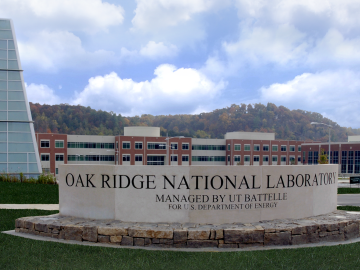Filter News
Area of Research
- (-) Fossil Energy (3)
- (-) Neutron Data Analysis and Visualization (4)
- Advanced Manufacturing (34)
- Biological Systems (18)
- Biology and Environment (177)
- Biology and Soft Matter (5)
- Building Technologies (12)
- Chemical and Engineering Materials (4)
- Chemistry and Physics at Interfaces (11)
- Clean Energy (522)
- Climate and Environmental Systems (14)
- Computational Biology (6)
- Computational Chemistry (5)
- Computational Engineering (5)
- Computer Science (19)
- Data (1)
- Earth Sciences (1)
- Electricity and Smart Grid (3)
- Energy Frontier Research Centers (14)
- Energy Sciences (5)
- Fuel Cycle Science and Technology (3)
- Functional Materials for Energy (16)
- Fusion and Fission (54)
- Fusion Energy (17)
- Geographic Information Science and Technology (3)
- Isotope Development and Production (3)
- Isotopes (35)
- Materials (432)
- Materials Characterization (2)
- Materials for Computing (36)
- Materials Synthesis from Atoms to Systems (13)
- Materials Under Extremes (12)
- Mathematics (1)
- National Security (78)
- Neutron Science (190)
- Nuclear Science and Technology (74)
- Nuclear Systems Modeling, Simulation and Validation (3)
- Nuclear Systems Technology (1)
- Quantum Condensed Matter (4)
- Quantum information Science (9)
- Reactor Technology (1)
- Renewable Energy (4)
- Sensors and Controls (5)
- Supercomputing (311)
- Transportation Systems (11)
News Type
Media Contacts

To improve models for drilling, hydraulic fracturing and underground storage of carbon dioxide, Oak Ridge National Laboratory scientists used neutrons to understand how water flows through fractured rock.

Scientists at the Department of Energy’s Oak Ridge National Laboratory have found a simple, reliable process to capture carbon dioxide directly from ambient air, offering a new option for carbon capture and storage strategies to combat global warming.
Initia...

In a new twist to waste-to-fuel technology, scientists at the Department of Energy’s Oak Ridge National Laboratory have developed an electrochemical process that uses tiny spikes of carbon and copper to turn carbon dioxide, a greenhouse gas, into ethanol. Their findin...

Neutron measurements at Oak Ridge National Laboratory’s Spallation Neutron Source are giving physicists new insight into the behavior of quantum magnets. A research team led by Young-June Kim from the University of Toronto used neutron spectroscopy to observe a novel type of energ...

Crude oil refinement can be an extremely costly chemical process. In an effort to reduce energy and cost demands, Oak Ridge National Laboratory researchers Anibal Ramirez-Cuesta and Stuart Campbell are collaborating with University of Nottingham (UK) researchers to develop metal-orga...

The Spallation Neutron Source at the Department of Energy’s Oak Ridge National Laboratory broke records for sustained beam power level as well as for integrated energy and target lifetime in the month of June.

The American Conference on Neutron Scattering returned to Knoxville this week, 12 years after its inaugural meeting there in 2002.




